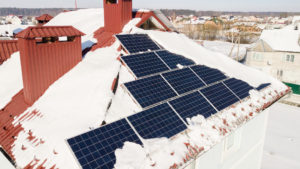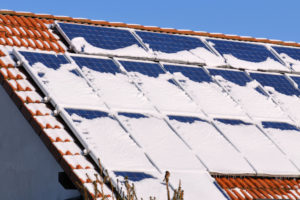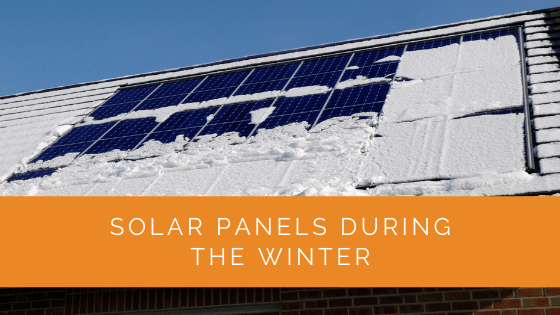When we try to imagine the optimal weather for solar panels to function, we see a bright sunny day. A common question that you might have would be that are solar panels effective only in sunny tropical states like Texas and California?
This is a common misconception that solar panels are not as effective in the winter months or in particularly colder states. In fact, it might sound hard to believe but solar panels generate electricity better in the cooler temperatures of winter.
Contents
Key Takeaways
- Solar panels are effective even during the winter months and in colder states, as they generate electricity more efficiently in cooler temperatures.
- Solar panels can still generate energy with snow on them, but a thick layer of snow can hamper their energy output.
- To optimize solar panel performance in snowy conditions, strategies like using dark panels, installing them at an angle, and taking advantage of the albedo effect can help increase energy production.
How Solar Cells Work
To understand the functioning of solar cells in winter, let’s first understand how it works. A solar panel is made of special units called PV cells or photovoltaic cells that are made with silicon. The electrons contained in the PV cells, when hit with the sun’s light get energized. This energy within the PV cells is then converted into energy.
Solar cells produce electricity even on days with cloud cover and low sunshine levels. This is possible because solar cells are able to use both diffuse and direct light. To simplify, direct light is when solar radiation travels in a straight line and diffuse light is when the radiation is scattered by the presence of any form of particles in the sky.
The efficiency of Solar Panels to produce energy tends to decrease if it crosses over the peak temperature. They are more likely to work in the winter since solar panels will probably not cross beyond their peak temperature. In fact, it can be said that in colder weather, solar power production will be at its peak efficiency.
In colder temperatures, the solar panels might get approximately 8 daylight hours for energy production. Generally speaking, solar panels work in the winter, better than in the warmer climate.

Can Solar Panels Generate Energy with Snow on Them?
Solar Panels can generate solar power even with snow on them since they do not rely on the sun’s heat but on the sunlight. However, if they are covered with a thick layer of snow then energy output will be hampered.
Here is how the negative impact of the winter weather can be minimized or avoided:
Dark Solar Panels
As is common knowledge, dark colors attract and trap heat. Dark solar panels can have the same effect as they would trap the sun’s rays causing the solar panels to warm up and consequently make the snow naturally melt. Generally, solar panels are warmer than the atmospheric temperature. Therefore, even a few rays of the sun’s light can result in the solar panels warming up.
Solar Panel Installation at an Angle
Solar installations are generally done at an angle that also happens to help snow slide off of the solar panels.
To improve solar panel performance in the months of heavy snow, they should be kept at a steeper angle in winters. This will help with optimizing the angle of direct sunlight and help the snow slide off.
Anti-Soiling Properties of Snow
When the snow melts, it takes the dirt accumulated on the solar arrays with it. Thus, the panels would not require light dusting as they would in the summer months.

Snow Increases Solar Energy Output
Surprisingly, solar panels work efficiently in snowy winters. Albedo effect is a phenomenon by which a part of the sunlight reflects back into the atmosphere when it hits Earth’s surface.
Snow reflects a lot more light of the sun since it is white. This Albedo effect is helpful when solar panels are surrounded by snow. In this scenario, the panels could absorb a lot of this sunlight and consequently generate more power and improve PV performance. This is most suitable in the northern climates to improve solar production.
Snow Guards
Snow guards are most suited for places that receive heavy snowfall during winter. This helps prevent the solar panels from damage caused by heavy snowfall. The surface of a solar array does not offer friction to snow which is why it might slide off the roof in big chunks and hurt anybody. The guards prevent this as they help the snow, fall off gradually.
Snow Removing Tools
The least recommended method is removing snow with the help of a solar panel rake. You should be super careful while using this as it could possibly damage the panels.
Expert Insights From Our Solar Panel Installers About Solar Panels During the Winter
Many people are surprised to learn that solar panels can actually perform more efficiently in cooler temperatures. The cold weather helps keep the panels from overheating, which can lead to higher energy output compared to the hotter months.
Solar Energy Consultant
Snow can enhance solar panel performance through the albedo effect, where sunlight reflects off the snow and increases the amount of light that panels can capture. It’s crucial to install panels at an angle to help snow slide off and maximize efficiency.
Lead Solar Technician
Dark solar panels are particularly effective in winter because they absorb heat, which helps melt snow quickly. This means less manual cleaning and maintenance, allowing the panels to continue generating electricity even in snowy conditions.
Senior Solar Installer
Case Study: Optimizing Solar Panel Performance During Winter Months
Background
Solar Panels Network USA was approached by a homeowner in Minnesota concerned about the performance of their solar panels during the harsh winter months. The client had heard that solar panels might not be effective in cold and snowy conditions and wanted to ensure their investment would still pay off during the winter.
Project Overview
The project aimed to assess the client’s current solar panel setup and implement strategies to optimize energy production during the winter. We focused on maximizing the efficiency of the existing system while educating the client about the benefits of solar panels in cold weather.
Implementation
Initial Assessment and Requirements Analysis
We started with a thorough inspection of the client’s solar panels and the overall setup. This included checking the angle of installation, the type of panels used, and any existing shading issues. The client’s energy consumption data was also analyzed to estimate the required energy production during winter months.
Optimization Strategies
- Adjusting the Angle of Panels: We recommended adjusting the angle of the solar panels to a steeper incline for the winter months. This not only helps with snow shedding but also optimizes the angle for capturing sunlight during the lower winter sun.
- Installing Dark Solar Panels: The client’s panels were replaced with dark-colored panels that absorb more heat. This helps in melting the snow quickly and keeps the panels operational.
- Utilizing the Albedo Effect: We educated the client on how the albedo effect can increase energy production. By reflecting sunlight off the snow, the panels could capture more light, thus enhancing performance.
- Adding Snow Guards: To prevent large chunks of snow from sliding off and causing damage or injury, snow guards were installed. These guards help the snow fall off gradually, protecting the integrity of the panels and the safety of the surrounding area.
Results
After implementing the optimization strategies, the client saw a noticeable improvement in the performance of their solar panels during the winter months. The energy production increased due to the better angle and the albedo effect. Additionally, the dark panels and snow guards ensured that the panels remained clear of snow and operational.
Summary
Solar panels can perform efficiently even in cold and snowy conditions if properly optimized. This case study demonstrates that with the right strategies, such as adjusting the panel angle, utilizing dark panels, and leveraging the albedo effect, solar panels can continue to provide substantial energy output during the winter. At Solar Panels Network USA, we are committed to helping our clients maximize their solar investments year-round, ensuring reliable and efficient energy production regardless of the season.
Experience Solar Excellence with Us!
Trust in Solar Panels Network USA, where our seasoned experts deliver top-quality solar solutions for homes and businesses nationwide. With a legacy of countless successful installations and a commitment to sustainable energy, we’re your reliable partner in the solar journey. Ready for a brighter, eco-friendly future? Call us now at (855) 427-0058 and harness the power of the sun!
Wrapping Up
Installing solar panels makes the most sense in places where electricity rates are high. Alaska has cold weather similar to Germany that has been a leading name in solar energy production for over a decade.
According to the Solar Energy Industries Association, the state of New York ranks in the top 10 for installing winter solar panels. A major driving factor for this is the high electricity rates.
The electric bills in a lot of states are so high that it makes sense for solar savings. This means going solar to reduce the electric bill. This source of renewable energy is worth installing as it can function in extreme weather conditions like low temperatures. To earn credits on your electricity bill, you should have net metering in place to track the excess energy you produce.
In short, in real-world conditions like cold climates, solar arrays serve a great purpose by reducing utility bills and working efficiently. Solar power is a reliable source of renewable energy in states with harsh winter months and heavy snow.
About the Author
Solar Panels Network USA stands at the forefront of solar energy solutions, driven by a team of seasoned solar engineers and energy consultants. With over decades of experience in delivering high-quality solar installations and maintenance, we are committed to promoting sustainable energy through customer-centric, tailored solutions. Our articles reflect this commitment, crafted collaboratively by experts to provide accurate, up-to-date insights into solar technology, ensuring our readers are well-informed and empowered in their solar energy decisions.

